Licia Filingeri
From the 5th century BC, let's now take a leap to the present day. Gerald Holton, professor of Physics and History of Science, in recent years has shown how, having overcome the process of validation in vogue until 1980, based on objective and rational criteria, it is important to realize that new insights in the field of history and philosophy of science are the result of the imagination of the man of science (see Pohlen , Holton states that "there has always existed another pair of antitheses or polarities.... namely between, on one hand, the Galilean (or more properly Archimedean) effort toward precision and measurement that purifies public and "objective" science from those qualitative elements that interfere with the achievement of reasonable "objective" agreement among researchers, and, on the other hand, the intuitions, fantasies, daydreams, and a priori positions that constitute half of the world of science as personal, private, and "subjective" activity. Science has always been pushed and bounced between these contrary and antithetical forces" (G. Holton, 1973).
The concept of Bifrontism appears to be exemplary of the concept of antithetical couple, and may even enlighten us on its origin.
Currently, it has a wider use than in the past, and permeates our culture in many areas: philosophical-existential, musical, stylistic, religious, political, economic, etc.. Let's take a closer look at some of its aspects.
In poetry, we find it among the rhetorical figures, such as metalepsis (greek name that means substitution, exchange), and palindrome (word or phrase that can be read equally in both directions, as shown by the perfect " magic square", of Pompeii, containing the palindrome phrase: " Sator arepo tenet opera rotas", " The sower, with his plow, keeps care of the wheels", then referred to the supreme god who wisely holds the universe, which could be read vertically and horizontally, from right to left and vice versa, so as to be considered over time magically endowed with extraordinary powers).
In Chiasmus, which takes its name from the letter " chi" of the Greek alphabet, there is precisely a cross shape, since the elements are arranged in inverse correspondence, so what is at the top right corresponds to what is at the bottom left and vice versa.
Bifrontism as a pair of opposites is a concept that is close to that of symmetry, in which instead the two parts that face each other are precisely symmetrical, that is perfectly equal.
In classical Greece, in sculpture, the perfect, geometric and mathematical symmetry of proportions of the opposite parts of the human body was the basis of the typical placement in the works of Polyclitus, in which the Canon identified in this balance the supreme ideal of beauty and harmony. The mathematical properties of symmetry have been studied in more recent times by the psychologists of perception, which aims to deepen the way in which it organizes the phenomenal world of each person, investigating the ways by which the individual immediately enters into cognitive relationship with the environment in which he lives, starting from visual perception, and then extending to all other senses (see Koffka, 1970; Vernon, 1964). To the psychology of perception we owe the underlining the importance of geometric regularity in the psychological field for the purposes of perception, starting from the observation that from symmetry derives an experience of tranquility; it is probable that from this derives the importance of symmetry, especially in the field of arts.
Limiting ourselves now to the field of visual arts, let's try to redo succinctly some paths, connected to the concept of bifrontism, for example in reference to the representation of deity.
We begin with an important civilization of the past, which has made great use of bifrontalism in the visual arts, namely the Sumerians. The bifrontism is frequent in the representations of its tablets and cylinders, an example for all: a two-faced image, that of Isimud, minister of the triad of deities An, En-lil, En-ki.
Let's move in time and space, at another great civilization, that of the Greeks. There is a character of Greek mythology, Argus, also called Argus Panoptes (ie "who sees everything"), depicted as a dog with a hundred eyes, which closed only half. when he slept. At his death, by Hermes, was transformed by Hera in the tail of the peacock. Here there is symmetry, both in relation to the fabled 100 eyes half closed and half open, and in relation to the "eyes" that can be seen on the beautiful tail of the peacock, when it does the wheel.
In later times, among the Celts, we find a double head in limestone of the third century BC.
It follows the Roman Janus ( Giano), whose cult was born from the observation of the eternal passage from one state to another. For this reason his temples were very simple: a long corridor, with an entrance and an exit, enter and exit, begin and end, be born and die, the eternal courses and recourses. The root of its name alludes to the concept of passage, like the Latin verb ire (to go), the Gaelic ya-tu (ford) and the Sanskrit yana (door). Originally, in historical depictions (sculptures and coins), of the two faces of Janus, one was bearded and the other was not, perhaps symbolizing the sun and the moon. In the second century BC, on coins, will be depicted with 4 faces,
Pliny the Elder (23-79 BC) represents him like a solar God with two faces.
Macrobius (IV century AD) in Saturnalia says that January (Januarius) is dedicated to Janus, god with two faces as it is merged with Artemis (Jana, ie Diana, corresponding to Diana Trivia and Hecate triform), that is the representation of sun and moon (called in fact by Varro -116-27 B C- Iana Luna. Varro claims that Janus was the god of the sky, practically identified with Juppiter ). Macrobius then recalls that the god is the guardian of the earth and roads, as Diana Trivia is the guardian of the crossroads.
Janus or Dianus, as also recalled by Frazer (1910), was originally the double of Jupiter. Janus would be the double of Jana (as Dianus of Diana), deriving their names from the same Aryan root DI, meaning shining with light.
Cicero (106-43 a.C.) in the De Natura Deorum, remembers Janus was called Eaunus, from eundo, (gerund of ire, that in Latin means to go, therefore " going ", because Janus is always on the move, just like the Phoenician serpent Ouroboros, the snake that eats its own tail, symbol of the eternal return of the stages of existence).
The legend also says that Janus, or Janus, of divine origin, would have reigned over Latium, first instituting religious rites and beginning the construction of temples. Consequently, he was the protector of the Collegia Opificum e Fabrorum, established under the reign of Numa and in his honor the guilds of Roman artisans celebrated the two solstitial feasts, being protector of every beginning and initiator of civilization .
The allegory of the double face and double forehead has been interpreted in various ways. It is connected to the gift of the science of the past and the future, given to him by Saturn, whom he hosted during the persecution by Jupiter. According to other interpretations, since the month of January (Januarius) takes its name from Janus and is dedicated to him, the double forehead that connotes the herms of the god would symbolize the vision of the past year and the one that is beginning.
From this to being the guardian of the doors (Ianitor, from janua, in Latin door ) and of every passage, therefore of every beginning (year, month, day, any incipit) the step is short. As a solar deity, Janus had control of the Gates of Heaven (Januae caelestis aulae) opened at dawn (East) and closed at sunset (West) by the Sun, which passed through with its shining chariot, as well as at the beginning and end of the solar year. His two faces represent therefore the two doors of the skies, the points in which the sun rises and falls. He was also a symbol of the opening and closing every year of the Solstitial Doors, through which the Sun begins its ascending and descending paths. In some representations Janus has a virile face, with a beard, and a feminine face, probably in relation to the symbolic meaning of Sun and Moon expressed by the couple Janus-Jana or Diano-Diana. The two faces, bearded-old and beardless-young, would also allude to his presiding over the passage of time.
The double face of Janus would then have lent itself to be an allusion to the Platonic conception of the human soul: in the young face one could see the divine aspect of the soul, attracted towards divinity and shining with celestial beauty; in the old face, one would see the caducity of human and earthly events, subject to becoming, and consequently destined to involution.
However, the most ancient representations of bifrontism date back to the Paleolithic.
The attribution is owed to Pietro Gaietto (1974) that in describing the art of the Paleolithic, connects it to the religions of the time, considering it as an instrument for cults and rituals, connecting it to the successive artistic representations of the post-Paleolithic and historical peoples, such as the Babylonians, the Phoenicians, the Thracians, the Celts, the Gauls, the Egyptians, the Greeks, the Romans, etc., rich in representations of deities with two or more heads, with one or more eyes, beings with human features with heads or parts of the body of animals.
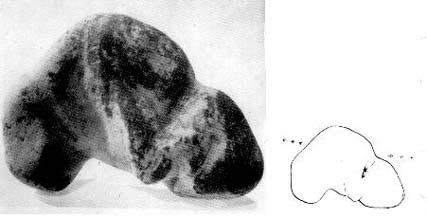
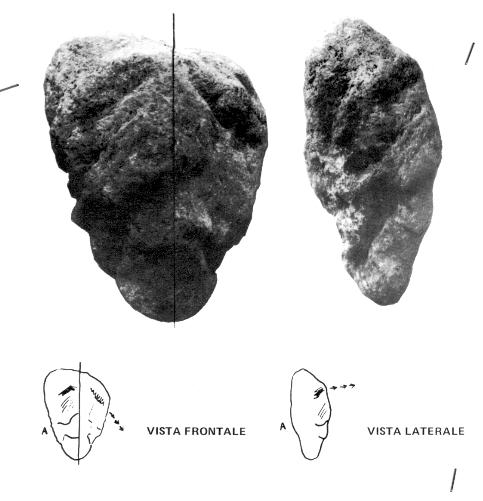
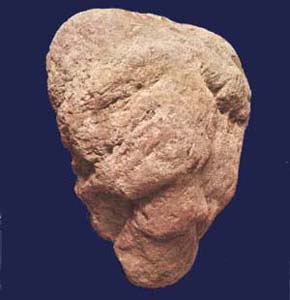
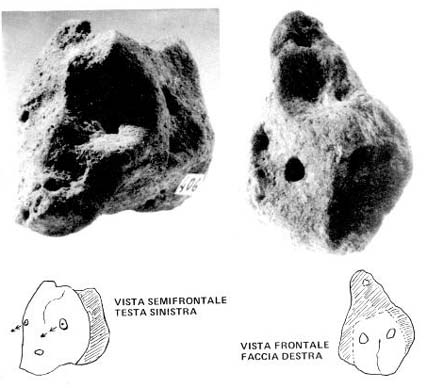
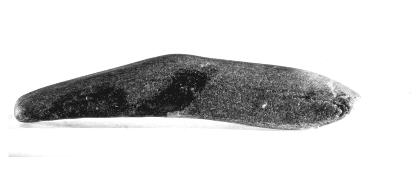
It should be remembered that the origin of bifrontism, in addition to having been presumably provoked by the numerous pairs of opposites that nature incessantly proposes and shows, can also be traced back to intrapsychic splitting mechanisms that, to a degree not excessive and appropriate to the phase, are found in the normal process of human development. This refers precisely to what Melanie Klein (1952) identified as the schizo-paranoid phase in the development of the child, corresponding to the perception of partial objects, around 3-4 months of age (see Klein, 1921-1924, for the definition of internal objects).
"We can suppose that man, after a long foetal preparatory life of millions of years, or perhaps shorter,at the light of the quantavolutionnist theories ( de Grazia, 1981), in that with complex gestation was developed his Self, just so "human", both,like the foetus, at neuro-physiological (Mancia, 1981) and at psychological level, ( Raskowsky, 1977), has found one of the first forms of expression and communication of internal objects of himself, just in the tools and art creation" (Filingeri,1984) .
Otto Rank, in his work The Double, connects the double to the emergence of the deepest distress of destruction of the ego, then in connection with death, in the sudden appearance in front of us of a doppelganger (our "double"), the undoing re-emerges with violence, overcoming the barriers of censorship, and the ego is overwhelmed by distress. Duplicity, then, is related to something that overwhelms us, as we said , and this insight from Rank reinforces the previously stated hypothesis that our earliest ancestors identified duplicity with the inqiueting, consequently with the supernatural, then with the spiritual, and then, presumably, with the image of a deity.
Freud will use the concept of Rank's double in his essay on The Perturbing, heimlich/unheimlich, contraposition between what is familiar and what is foreign to us, perturbing, precisely
In the present day, in our cultures, the two-faced figure continues to exercise its fascination, even in the visual arts. An example for all, and just from a place so far away from those in which in the past the culture of two-faced figures was most developed: at Clyde River (Baffin Island), sculptors representing Inuit Arctic sculpture currently use whale vertebrae to depict two-faced Janus, and this is also considered a way of using natural shapes. Thus we return from so far back to the origins, and the circle is closed....BR>
BIBLIOGRAPHY<
DE GRAZIA, A.,(1981), Chaos and Creation, Metron, Princeton
FILINGERI, L.,(1984),Psychodynamic considerations at margin of presulpture and prehistorical sculpture interpretattions, Primeval Sculpture, 1:16-19
FRAZER, J.G., (1910), Il ramo d'oro, Torino, Boringhieri, 1973
GAIETTO, P., (1974),L'Arte Vergine, C.S.I.O.A., Genova
GAIETTO, P., (1982), Prescultura e Scultura preistorica, E.R.G.A., Genova
HOLTON, G., (1973), Thematic Origins of Scientific Thought: Kepler to Einstein. Cambridge, MA, Harvard University Press
KLEIN. M.,(1921-24), A Contribution to the Psychogenesis of Maniac- Depressive States, in Contributions to Psycho-Analysis,Hogarth Press, London, 1948
KLEIN,M., (1952), Some Theoretical Conclusions Regarding the Emotional Life of the Infant, in (various authors)Developments in Psycho-Analysis, Hogarth Press, London
KOFFKA, K. (1970), Principi di psicologia della forma, Boringhieri, Torino
MANCIA,M.,(1981), On the beginning of mental life in the foetus, Int.J.Psycho-Anal.,62:351-357
POHLEN, M.,(1998), Che cos'è la psicoterapia come scienza?, Psicoterapia e Scienze Umane, 2/2000 , in Psychomedia, Editoria, Recensioni
RANK, O., (1914), Il Doppio, SugarCO, Milano,1979
RASKOWSKY,A., (1977), El Psiquismo fetal, Paidos, Buenos Aires
VERNON, M.D. (1964), La psicologia della percezione, Martello, Milano
Copyright©2000-2002 by Paleolithic Art Magazine, all rights reserved